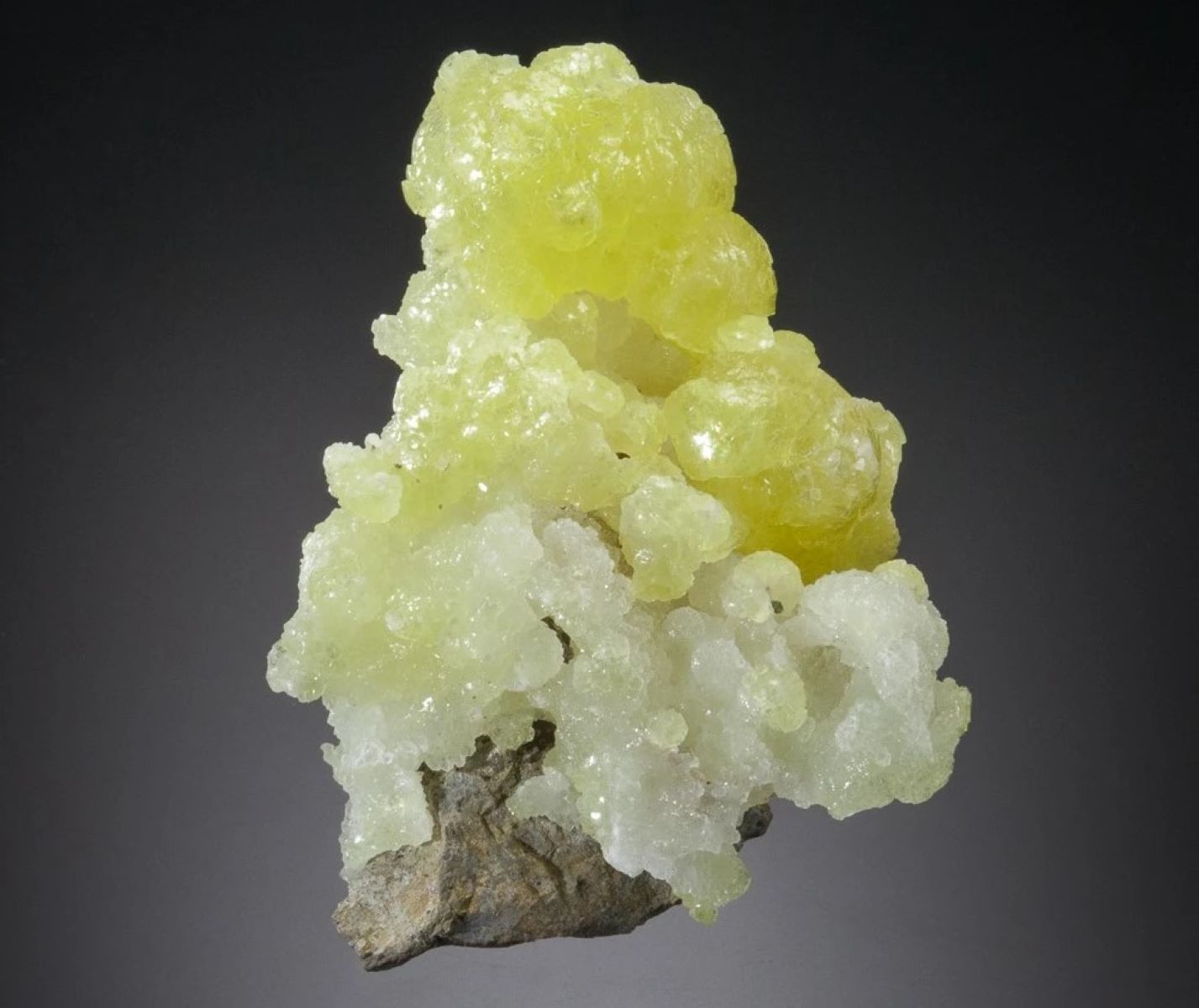
Ever heard of amakinite? This semi-transparent yellow-green mineral, first found in 1962, has a lot more to it than meets the eye. Named after the Amak River in the Soviet Union, amakinite belongs to the brucite group and boasts a unique chemical formula: (Fe2+, Mg)(OH)2. Its pale green hue quickly turns brown when exposed to air, thanks to the formation of iron(III) hydroxide. Found in kimberlite pipes, amakinite forms under high-temperature, high-pressure conditions. Rare and intriguing, this mineral offers a glimpse into the Earth's deep geological processes. Ready to learn more about this fascinating mineral? Let's dive in!
Key Takeaways:
- Amakinite is a rare yellow-green mineral with unique properties, forming in high-temperature, high-pressure conditions. Its reactivity with air and association with kimberlite make it a fascinating subject for scientific research and mineral collectors.
- The discovery of amakinite in 1962 expanded our understanding of Earth's mineral diversity. Ongoing research on its crystal structure and geological occurrences provides valuable insights into our planet's geological history.
What is Amakinite?
Amakinite is a semi-transparent yellow-green hydroxide mineral that belongs to the brucite group. Discovered in 1962, it has since intrigued geologists and mineral enthusiasts alike. Let's dive into some fascinating facts about this unique mineral.
-
Discovery and Naming
Amakinite was discovered in 1962 and named after the Amak River in the Soviet Union, where it was first found. The International Mineralogical Association (IMA) assigned the symbol "Amk" to this mineral. -
Chemical Composition
The chemical formula for amakinite is (Fe2+, Mg)(OH)2. This indicates that it is a hydroxide mineral composed of iron and magnesium ions. -
Crystal System
Amakinite crystallizes in the trigonal crystal system. This means that its crystal structure is characterized by three axes of symmetry, with the angles between them being 120 degrees. -
Color and Appearance
Amakinite typically exhibits a pale green to yellow-green color. However, it rapidly turns brown when exposed to air due to the formation of iron(III) hydroxide (Fe(OH)3).
Physical Properties of Amakinite
Understanding the physical properties of amakinite can help in identifying and studying this mineral. Here are some key characteristics:
-
Cleavage
The cleavage of amakinite is poor or indistinct. This means that the mineral does not break easily along specific planes, unlike some other minerals that exhibit good cleavage. -
Fracture
The fracture of amakinite is irregular or uneven. This indicates that the mineral breaks in a way that does not follow any specific plane or direction. -
Mohs Hardness
Amakinite has a Mohs hardness of 3.5 to 4. This places it in the relatively soft category of minerals, which can be scratched by a copper penny. -
Specific Gravity
The specific gravity of amakinite ranges from 2.925 to 2.98. This is slightly higher than the specific gravity of water, indicating that the mineral is denser. -
Optical Properties
Amakinite exhibits uniaxial optical properties. This means that it shows different refractive indices along different axes, which can be observed under a polarizing microscope.
Geological Occurrences
Amakinite's geological occurrences provide insights into the conditions under which it forms. Here are some notable points:
-
Geological Occurrences
Amakinite is typically found in the form of splotchy, anhedral crystals. These crystals often form within a group or structure in other minerals or rocks, such as kimberlite, which is a type of diamond-rich eruptive pipe. -
Kimberlite Association
Amakinite is commonly associated with kimberlite. This association is significant because kimberlite pipes are known for their unique geological and mineralogical features, including the presence of diamonds and other rare minerals. -
Formation Conditions
The formation conditions of amakinite are not well-documented, but it is believed to form under high-temperature and high-pressure conditions. These conditions are typical of those found in the Earth's mantle and upper crust. -
Rarity
Amakinite is a relatively rare mineral. Its scarcity is due to its specific formation conditions and the limited areas where it can be found. -
Distribution
The distribution of amakinite is primarily limited to specific regions where kimberlite pipes are known to exist. These regions include parts of the Soviet Union, Africa, and other areas where kimberlite pipes have been identified.
Mineral Group and Composition
Amakinite belongs to a specific group of minerals and has a unique composition. Let's explore these aspects:
-
Mineral Group
Amakinite belongs to the brucite group of minerals. This group includes other hydroxide minerals that share similar chemical and structural properties. -
Hydroxide Composition
As a hydroxide mineral, amakinite contains hydroxide ions (OH-) in its structure. This composition is characteristic of brucite group minerals and contributes to their unique properties. -
Iron and Magnesium Content
The presence of iron and magnesium ions in amakinite's structure is significant. These ions contribute to its color and reactivity, particularly the rapid change to brown when exposed to air.
Reactivity and Stability
Amakinite's reactivity and stability are important factors to consider, especially for collectors and researchers:
-
Reactivity with Air
The reactivity of amakinite with air is notable. When exposed to oxygen, it rapidly forms iron(III) hydroxide, which changes its color from green to brown. This reactivity is due to the oxidation of iron ions in the mineral's structure. -
Stability in Water
Amakinite is not particularly stable in water. Its hydroxide composition makes it susceptible to dissolution in aqueous environments, which can lead to its degradation over time.
Geological Processes and Significance
The geological processes that form amakinite and its significance in mineralogy are worth noting:
-
Geological Processes
The geological processes that form amakinite are complex and involve high-temperature and high-pressure conditions. These processes are typically associated with the formation of kimberlite pipes and other volcanic rocks. -
Mineralogical Significance
Amakinite has significant mineralogical importance due to its unique composition and properties. It provides insights into the geological conditions under which it forms and the chemical processes involved in its formation.
Research and Collection
Amakinite continues to be a subject of scientific research and is also sought after by collectors:
-
Scientific Research
Scientific research on amakinite is ongoing, focusing on its crystal structure, chemical composition, and geological occurrences. These studies help in understanding the Earth's geological history and the processes that shape our planet. -
Collection and Display
Amakinite specimens are highly sought after by mineral collectors due to their rarity and unique appearance. However, their reactivity with air requires special care in handling and display to preserve their color and integrity.
Educational and Industrial Value
Amakinite serves various educational purposes and contributes to our understanding of geological processes:
-
Educational Value
Amakinite serves as an educational tool for geology students and enthusiasts. Its unique properties and formation conditions make it an excellent example for teaching about mineralogy, geology, and the Earth's processes. -
Industrial Applications
While amakinite does not have significant industrial applications, its study contributes to our understanding of the Earth's geological processes. This knowledge can be applied in various fields, including mining, geotechnical engineering, and environmental science.
Environmental Impact and Comparisons
Understanding the environmental impact of amakinite and comparing it with other minerals can provide further insights:
-
Environmental Impact
The environmental impact of amakinite is minimal due to its rarity and limited distribution. However, its study can provide insights into the environmental conditions under which it forms, which can be relevant for understanding broader geological and environmental processes. -
Comparison with Other Minerals
Amakinite can be compared with other minerals in the brucite group, such as brucite itself. While both minerals share similar hydroxide compositions, they differ in their iron and magnesium content, leading to distinct physical and chemical properties.
Historical and Future Research
The discovery of amakinite and future research directions are important to consider:
-
Formation in Kimberlite Pipes
The formation of amakinite within kimberlite pipes is a significant aspect of its geological occurrence. Kimberlite pipes are known for their unique mineralogical features, including the presence of diamonds and other rare minerals like amakinite. -
Historical Significance
The discovery of amakinite in 1962 marked an important milestone in mineralogy. It expanded our knowledge of the Earth's mineral diversity and highlighted the need for further research into the geological processes that shape our planet. -
Future Research Directions
Future research on amakinite is likely to focus on its crystal structure, chemical composition, and geological occurrences. Advances in analytical techniques such as X-ray diffraction and electron microscopy will continue to provide insights into this fascinating mineral.
The Fascinating World of Amakinite
Amakinite, with its semi-transparent yellow-green hue and unique properties, stands out in the mineral world. Discovered in 1962 near the Amak River, this rare hydroxide mineral is primarily found in kimberlite pipes. Its chemical formula, (Fe2+, Mg)(OH)2, reveals a composition rich in iron and magnesium. Amakinite's trigonal crystal system, poor cleavage, and irregular fracture make it distinct. Though relatively soft, with a Mohs hardness of 3.5 to 4, it’s dense, boasting a specific gravity of 2.925 to 2.98.
Exposure to air quickly turns amakinite brown due to iron(III) hydroxide formation. Its rarity and specific formation conditions add to its allure for collectors and researchers. While it lacks significant industrial applications, amakinite's study enhances our understanding of geological processes. This mineral's story, from its discovery to its scientific importance, underscores the endless wonders hidden within our planet.
Frequently Asked Questions
Was this page helpful?
Our commitment to delivering trustworthy and engaging content is at the heart of what we do. Each fact on our site is contributed by real users like you, bringing a wealth of diverse insights and information. To ensure the highest standards of accuracy and reliability, our dedicated editors meticulously review each submission. This process guarantees that the facts we share are not only fascinating but also credible. Trust in our commitment to quality and authenticity as you explore and learn with us.


